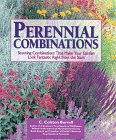Perennial gardening concentrates on establishing permanent plant areas and eliminates the need to sow and plant each year. That saves on cost and effort.
With perennial gardening the plants really do become the gardener's friend as the perennial life cycle is not restricted to 1 or 2 years.
Of course, you can reinforce your perennials with annuals, but perennials will form a permanent and reliable structure to your garden. For this reason, be careful to match your perennials to suite the growing conditions of a particular site. Also, consider the eventual size of your plants, and how they fit the available space. Think about impact and scale in relation to plant size. Base your perennial gardening style on nature.
Most people think of perennials as herbaceous or leafy plants that die down at the end of each year to grow back again the next. Don’t forget too, that bulbs, shrubs and evergreens are valuable perennials capable of extending the garden season. Bulbs produce early season flowers. Shrubs provide colorful autumn leaves and berries and some winter flowers too.
Herbaceous perennials
Many herbaceous perennials lie dormant over winter with their buds at or just below soil level. They survive the winter as a rootstock bearing a stem with leaf buds, or as underground stems and roots.
Ensure your perennials are labelled before they die down in autumn. Tidy up dying vegetation in autumn and dead-head. Remove stems that would otherwise rock the plant loose in the wind. Otherwise leave for winter protection. Perennials can be winter protected with free-draining fibrous mulch such as bracken, shredded hedge trimmings or well-rotted leaf mould.
But not all perennials die back completely in winter. Sometimes new leaf rosettes form in autumn to overwinter, and ready for spring. Alpines in particular like Armeria maritima survive as leafy tufts and Primulas often retain a rosette of leaves throughout. Of course evergreen perennials like heathers can be very attractive at this time.
^ Top of page
Look out for bulbs, corms, rhizomes, root tubers and tap roots
Perennials can also survive the winter as dormant storage organs that grow as modified roots, stems or leaves. The roots of Paeonia for example swell up to form root tubers from which the plant normally produces strong re-growth in spring.
Lupins have deep growing tap roots.
Anemone survives as a rhizome – an underground stem and storage organ. Rhizome growth is horizontal, their buds sprout in spring.
Gladiola and Cyclamen survive as corms - wide vertically growing underground stems and storage organs.
Half-hardy perennials
Garden Chrysanthemums are half-hardy perennials. Although capable of surviving for several years, they need protection from cold wet winter conditions. In the autumn a short stem and rootstock referred to as a stool is dug up. After removing the leaves, place in boxes, cover over with sand and store in a cool place.
Dahlia root tubers, and Gladiola corms are further examples of half-hardy perennials.
So in northern areas dig up the tubers or corms and store over winter for planting out next spring just like Chrysanthemums mentioned above.
^ Top of page
Propogating perennials
You can propagate corms and rhizomes by breaking off new branches and growing separately. But leave a few years to build up sizeable branches before division.
Many perennials can be divided in autumn or spring. Where new shoots appear at the base of the stem it is often possible to take cuttings. With Chrysanthemum, cuttings are taken in autumn before removal to storage. These are grown in pots indoors.
You can increase stocks of perennial clumps by division. Underground stems and rootstocks are divided to make several plants each with buds for growing anew. To divide a congested perennial clump, did up the clump and insert two forks back to back. Then lever the forks apart. Astilbe, Red Hot Poker (Kniphofia), are just two plants on which this can be practised. Sometimes it’s better to use a spade or secatures. You can divide perennials about every 3-4 years.
To understand this better, pay attention to the pattern of buds and branching. New leaves come from the buds. Stem extension is made by a terminal bud and sometimes from side buds branching out. Are your clumps growing outward leaving the centre of the plant old and bare? Obviously, division into smaller parts each with fresh buds for regrowth followed by replanting, will regenerate such a clump. Discard the old parts, but use the spare fresh pieces to plant another garden area. You can also pot up and sell on, exchange them with gardeners for plants you want, give them away, or compost them.
Planting perennials
You can plant perennials between autumn and spring when the ground is workable. I prefer to give them time to settle in before the cold of winter or the drought of summer. In dry ground puddle them in. Generally plants that die back in winter should be planted about 1" below soil level.
^ Top of page
Feeding perennials
As perennial gardening always occupies the same space, you need to pay attention to feeding. Fork in
Fish Blood and Bone
in spring as a general organic fertilizer. Use
Hoof and Horn
to supply nitrogen to big leafy perennials or mulch with manure.
Use
Bone Meal
to supply phosphates to Paeoni and when preparing ground for root tubers and corms, like Dahlias and Gladiola. But avoid using Bone Meal on lime hating plants such as Azaleas, Rhododendrons, and heathers.
You can also spray a folia feed of seaweed extract and Fish Emulsion to promote strong root growth and general improvement, especially for early flowers.
With perennial gardening there can be something to look forward to all year around. Enjoy your perennial gardening.
BOOKS ABOUT PERENNIAL GARDENING





